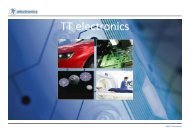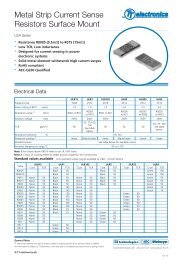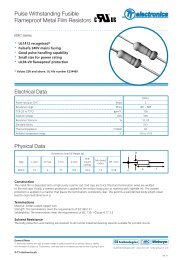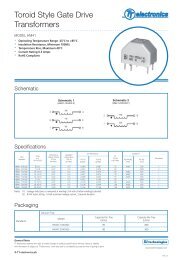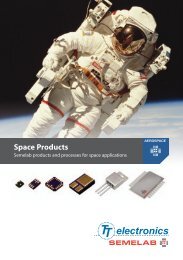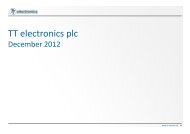Tubular Vitreous Enamelled Wirewound Resistors - TT electronics ...
Tubular Vitreous Enamelled Wirewound Resistors - TT electronics ...
Tubular Vitreous Enamelled Wirewound Resistors - TT electronics ...
You also want an ePaper? Increase the reach of your titles
YUMPU automatically turns print PDFs into web optimized ePapers that Google loves.
<strong>Tubular</strong> <strong>Vitreous</strong> <strong>Enamelled</strong><br />
<strong>Wirewound</strong> <strong>Resistors</strong><br />
<strong>Tubular</strong> <strong>Vitreous</strong> <strong>Enamelled</strong><br />
<strong>Wirewound</strong> <strong>Resistors</strong><br />
1600/1900 Series<br />
1600/1900 Series<br />
Welwyn Components<br />
Tapped <strong>Resistors</strong> See Figure 10<br />
Fixed resistors can be supplied with taps to special order.<br />
Because of the reduced winding length, the total resistance of<br />
a tapped resistor will be less than can be offered on a fixed<br />
resistor of the same size. The reduction is proportional to the<br />
number of taps and Table 5 is intended as a guide.<br />
The minimum resistance per section on all sizes is 1Ω and the<br />
standard selection tolerance for any section is ±10%<br />
Ordering Procedure<br />
Enquiries for tapped resistors must state the following details:<br />
Resistance per section<br />
Maximum dissipation per section<br />
Maximum operating ambient temperature<br />
Maximum permissible dimensions if important<br />
Type of terminations required. (See ‘Terminations’, page 3)<br />
Resistor style or proposed method of mounting.<br />
Table 5<br />
Maximum* Maximum* Maximum*<br />
total resistance number<br />
dissipation with single of taps<br />
in 20°C<br />
tap<br />
ambient<br />
(ohms)<br />
(watts) with<br />
Type<br />
single tap<br />
1905 14.5 9k 1<br />
1600 15.0 12k 1<br />
1602 15.5 9k 1<br />
1906 19.0 13k 1<br />
1603 22 18k 1<br />
1604 31 29k 2<br />
1605 41 34k 2<br />
1908 47 38k 2<br />
1607 66 53k 2<br />
1606 80 78k 4<br />
1608 101 93k 4<br />
1609 145 140k 4<br />
*Maximum total dissipation assumes that this will be<br />
evenly spread over the total element length.<br />
Low Inductance <strong>Resistors</strong><br />
Ayrton-Perry wound elements are supplied for low inductance<br />
applications. This winding style has a maximum permissible<br />
hot spot temperature of 300°C. The maximum dissipation is<br />
defined in Table 1 under the heading Operating hot spot<br />
temperature of 300°C, and resistance ranges are defined in<br />
the three right-hand columns of this table.<br />
Application Notes<br />
When cold, vitreous enamel has excellent insulation resistance.<br />
In common with all insulants the specific resistance of the<br />
enamel decreases with increased temperature; therefore, if<br />
operated at any temperature approaching the maximum, the<br />
resistor cannot be classed as an insulated type and should not<br />
be used in contact with any conducting materials.<br />
The recommended dissipations for each of the resistor hot<br />
spot temperatures applies to resistors mounted horizontally. If<br />
the bore is completely blocked a 15% derating is<br />
recommended. However, wherever possible, resistors should<br />
be mounted vertically with unobstructed bore.<br />
This makes best use of the chimney effect of the heated tube<br />
and will encourage a cooling stream of air through the bore.<br />
Allowances must be made, when tubular resistors are mounted<br />
in banks, for the effects produced by radiation between tubes.<br />
Appreciable reduction of hot spot temperature can be<br />
achieved by arranging that resistors are subjected to some<br />
measure of forced draught. In general, it is most efficient to<br />
extract air from the resistor enclosure and arrange that an air<br />
inlet is adjacent to the bottom of the tubes.<br />
If soft soldered connections are used the resistors should be derated<br />
where applicable to limit the hot spot temperature to 300°C.<br />
General Note<br />
<strong>TT</strong> <strong>electronics</strong> reserves the right to make changes in product specification without notice or liability.<br />
All information is subject to <strong>TT</strong> <strong>electronics</strong>’ own data and is considered accurate at time of going to print.<br />
www.bitechnologies.com www.irctt.com www.welwyn-tt.com<br />
© Welwyn Components Limited Bedlington, Northumberland NE22 7AA, UK<br />
© Telephone: <strong>TT</strong> <strong>electronics</strong> +44 (0) 1670 plc<br />
822181 · Facsimile: +44 (0) 1670 829465 · Email: info@welwyn-tt.com · Website: www.welwyn-tt.com<br />
<br />
08. 11<br />
123



